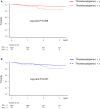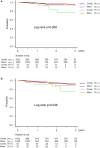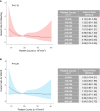Thrombocytopenia as a Bleeding Risk Factor in Atrial Fibrillation and Coronary Artery Disease: Insights From the AFIRE Study
- PMID: 37815031
- PMCID: PMC10757527
- DOI: 10.1161/JAHA.123.031096
Thrombocytopenia as a Bleeding Risk Factor in Atrial Fibrillation and Coronary Artery Disease: Insights From the AFIRE Study
Abstract
Background Thrombocytopenia poses a risk of bleeding in patients with chronic coronary syndrome after coronary intervention. However, whether thrombocytopenia also increases the bleeding risk in patients with atrial fibrillation and chronic coronary syndrome remains unclear. Methods and Results This study evaluated the AFIRE (Atrial Fibrillation and Ischemic Events With Rivaroxaban in Patients With Stable Coronary Artery Disease) trial. Thrombocytopenia was defined as platelet count <100 000/mm3 level at enrollment. Primary end points included incidence of major bleeding based on the International Society on Thrombosis and Hemostasis criterion and major adverse cardiovascular ischemic events (cardiac death, myocardial infarction, and stroke). A total of 2133 patients were classified into the thrombocytopenia (n=70) and nonthrombocytopenia (n=2063) groups. Major bleeding was significantly higher in the thrombocytopenia group than in the nonthrombocytopenia group (10.0% versus 4.1%, P=0.027). The thrombocytopenia group tended to have a higher risk of major adverse cardiovascular ischemic events (11.4% versus 6.2%, P=0.08). The bleeding incidence was significantly higher in patients with thrombocytopenia receiving combination therapy with rivaroxaban and a single antiplatelet drug (thrombocytopenia group, 14.3%, versus nonthrombocytopenia group, 5.0%; hazard ratio, 3.18 [95% CI, 1.27-7.97], P=0.014). Thrombocytopenia was an independent predictor of major bleeding (hazard ratio, 2.57 [95% CI, 1.19-5.56], P=0.017). Conclusions Among patients with atrial fibrillation and chronic coronary syndrome, thrombocytopenia was significantly associated with increased risk of major bleeding. Selecting drugs for patients with thrombocytopenia continuing antithrombotic therapy should be given special consideration. Registration URL: https://www.clinicaltrials.gov; Unique identifier: NCT02642419. https://www.umin.ac.jp/ctr/; Unique identifier: UMIN000016612.
Keywords: atrial fibrillation; chronic coronary syndrome; thrombocytopenia.
Figures



References
-
- Kiviniemi T, Karjalainen P, Rubboli A, Schlitt A, Tuomainen P, Niemelä M, Laine M, Biancari F, Lip GY, Airaksinen KE. Thrombocytopenia in patients with atrial fibrillation on oral anticoagulation undergoing percutaneous coronary intervention. Am J Cardiol. 2013;112:493–498. doi: 10.1016/j.amjcard.2013.04.007 - DOI - PubMed
Publication types
MeSH terms
Substances
Associated data
- Actions
LinkOut - more resources
Full Text Sources
Medical

